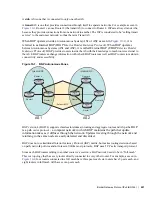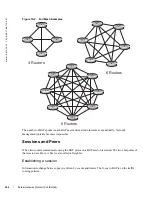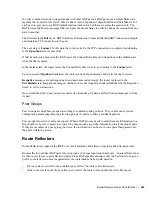
Border Gateway Protocol IPv4 (BGPv4) |
215
One AS assigns the MED a value and the other AS uses that value to decide the preferred path. For this
example, assume the MED is the only attribute applied. In
Figure 10-6
, AS100 and AS200 connect in two
places. Each connection is a BGP session. AS200 sets the MED for its T1 exit point to 100 and the MED
for its OC3 exit point to 50. This sets up a path preference through the OC3 link. The MEDs are advertised
to AS100 routers so they know which is the preferred path.
An MED is a non-transitive attribute. If AS100 sends an MED to AS200, AS200 does not pass it on to
AS300 or AS400. The MED is a locally relevant attribute to the two participating Autonomous Systems
(AS100 and AS200).
Note that the MEDs are advertised across both links, so that if a link goes down AS 1 still has connectivity
to AS300 and AS400.
Figure 10-6. MED Route Example
Origin
The Origin indicates the origin of the prefix, or how the prefix came into BGP. There are three Origin
codes: IGP, EGP, INCOMPLETE.
•
IGP indicated the prefix originated from information learned through an interior gateway protocol.
•
EGP indicated the prefix originated from information learned from an EGP protocol, which NGP
replaced.
•
INCOMPLETE indicates that the prefix originated from an unknown source.
Note:
With FTOS Release 8.3.1.0, configuring the
set metric-type internal
command in a route-map
advertises the IGP cost as MED to outbound EBGP peers when redistributing routes. The configured
set
metric
value overwrites the default IGP cost.
Router A
Router B
AS 100
Router C
T1 Link
OC3 Link
Set MED to 50
Set MED to 100
AS 200
Router D
Router E
Summary of Contents for Force10 E300
Page 1: ...FTOS Configuration Guide FTOS 8 4 2 7 E Series TeraScale C Series S Series S50 S25 ...
Page 32: ...32 w w w d e l l c o m s u p p o r t d e l l c o m ...
Page 132: ...132 802 1X w w w d e l l c o m s u p p o r t d e l l c o m ...
Page 310: ...310 Configuration Replace and Rollback w w w d e l l c o m s u p p o r t d e l l c o m ...
Page 330: ...330 Dynamic Host Configuration Protocol w w w d e l l c o m s u p p o r t d e l l c o m ...
Page 402: ...402 High Availability w w w d e l l c o m s u p p o r t d e l l c o m ...
Page 462: ...462 Interfaces w w w d e l l c o m s u p p o r t d e l l c o m ...
Page 482: ...482 IPv4 Addressing w w w d e l l c o m s u p p o r t d e l l c o m ...
Page 506: ...506 IPv6 Addressing w w w d e l l c o m s u p p o r t d e l l c o m ...
Page 582: ...582 Layer 2 w w w d e l l c o m s u p p o r t d e l l c o m ...
Page 642: ...642 Multicast Source Discovery Protocol w w w d e l l c o m s u p p o r t d e l l c o m ...
Page 662: ...662 Multiple Spanning Tree Protocol w w w d e l l c o m s u p p o r t d e l l c o m ...
Page 690: ...690 Object Tracking w w w d e l l c o m s u p p o r t d e l l c o m ...
Page 754: ...754 PIM Dense Mode w w w d e l l c o m s u p p o r t d e l l c o m ...
Page 784: ...784 PIM Source Specific Mode w w w d e l l c o m s u p p o r t d e l l c o m ...
Page 800: ...800 Power over Ethernet w w w d e l l c o m s u p p o r t d e l l c o m ...
Page 876: ...876 Quality of Service w w w d e l l c o m s u p p o r t d e l l c o m ...
Page 892: ...892 Routing Information Protocol w w w d e l l c o m s u p p o r t d e l l c o m ...
Page 1006: ...1006 Simple Network Management Protocol w w w d e l l c o m s u p p o r t d e l l c o m ...
Page 1018: ...1018 SONET SDH w w w d e l l c o m s u p p o r t d e l l c o m ...
Page 1048: ...1048 Broadcast Storm Control w w w d e l l c o m s u p p o r t d e l l c o m ...
Page 1096: ...1096 Uplink Failure Detection UFD w w w d e l l c o m s u p p o r t d e l l c o m ...
Page 1098: ...1098 Upgrade Procedures w w w d e l l c o m s u p p o r t d e l l c o m ...
Page 1196: ...1196 C Series Debugging and Diagnostics w w w d e l l c o m s u p p o r t d e l l c o m ...
Page 1252: ...1252 Standards Compliance w w w d e l l c o m s u p p o r t d e l l c o m ...
Page 1262: ...1262 Index w w w d e l l c o m s u p p o r t d e l l c o m ...



































